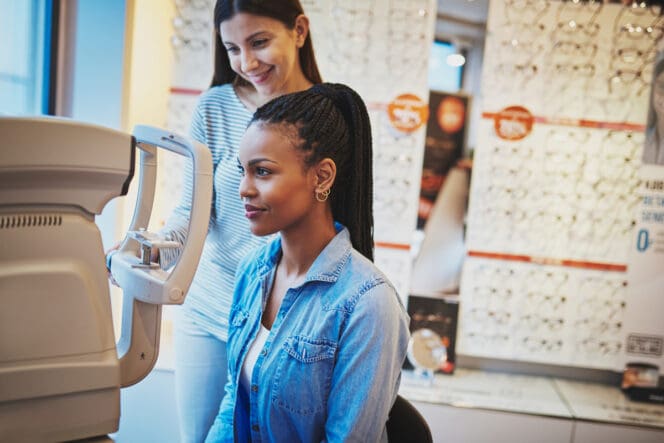Having 20/100 vision means you must stand no more than 20 feet away from an object to see it clearly, while someone with normal vision can see it clearly from 100 feet away.

20/100 vision qualifies as having low vision, which needs eyeglasses to correct.
Normal visual acuity is 20/20 vision, while 20/200 vision with a field of vision of 20 percent or less means being legally blind.
Understanding Visual Acuity and What 20/100 Means
Generally, 20/100 vision means that you cannot perceive objects far away from you. To be more specific, it means you would have to get within 20 feet of an object to see it clearly, something a person with normal vision can do from 100 feet away.
Visual acuity refers to the sharpness and clarity of vision. It is about eyesight strength which allows you to distinguish shapes and object details at a given distance. Normal visual acuity is 20/20. Although it is clear and sharp, it does not necessarily mean it is perfect.
Visual acuity describes the clarity of vision at a specific distance, usually 20 feet. Refractive errors, myopia, astigmatism, hyperopia, and eye diseases affect visual acuity. The visual acuity score provides a quick gauge of your ability to see an object 20 feet away compared to an average person viewing the same object from the same distance.
Eye caregivers use numbers and letters on a chart at a given distance to measure visual acuity, typically the Snellen Eye chart. If you can read the second line on the chart from 20 feet away, you have a 20/100 visual acuity.
What Is Low Vision and Legally Blind?
In medical terms, if you have 20/70 visual acuity, you have low vision. That means you have an uncorrectable vision acuity, which often originates from an eye disease that interferes with day-to-day life. And it means you don’t have sufficient vision clarity to conduct everyday activities.
Low vision usually starts with struggling to recognize faces, reading and fixing things. You will have a hard time working under standard lighting. Even with all these visual issues, low vision is not blindness. Various factors can bring about low vision, such as:
- Stroke
- Glaucoma
- Macular degeneration
- Stroke
- Diabetic retinopathy
Legal blindness refers to having 20/200 visual acuity or a field of vision that lies less than 20 degrees. 20/200 vision means that a person with normal vision can view an object 200 feet away comfortably, but you must stand 20 feet from the same object to see it clearly.
Since legal blindness is essential in determining disability benefits and tax exemption eligibility, the government emphasizes distinguishing legal blindness from total blindness.
Can You Improve 20/100 Vision?
To improve 20/100 vision, you will have to wear eyeglasses. Glasses are most applicable in reading to balance your eyesight. Using glasses ensures you do not squint and strain your eyes.
Understanding the Difference between 20/100, 20/200 and 20/400 Vision
When you have 20/100 vision acuity, it means that you can only get a clear view of objects 20 feet away that someone with no vision issues can view from 100 feet away. The same applies to 20/200 vision, where you can only view an object at 20 feet when a person with normal vision can view the same object at 200 feet.
Similarly, if you have 20/400 vision, it means you must be 20 feet away to view an object that a normal-vision person can view at 400 feet away.
The primary difference between the three levels of visual acuity is that if you have 20/200 and 200/400 visual acuities, then it means you have severe vision loss. Visual acuity lower than 20/400 is profound vision loss.
Devices to Help with Low Vision
If you want to get ahead of the condition, seeing an eye expert for a low vision exam is essential. It will tell you how much of the vision you can utilize. After diagnosis, you may have to choose between optical and non–optical devices to help with low vision, including:
- Refracted glasses
- Magnifying spectacles
- Stand magnifiers
- Hand-held magnifiers
Refracted Glasses
The ophthalmologist will use the cycloplegic refraction procedure to place eye drops and relax the muscles charged with focusing. That helps them estimate the extent of your refractive errors. Measurement of accommodation should follow. That way they can competently prescribe refractive glasses, which are more effective when applied at the onset of low vision.
Magnifying Spectacles
The way to wear magnifying spectacles is similar to eyeglasses, and it is hands-free. The best application for these spectacles is in reading and needle threading. Using the spectacles requires placing objects closer than with standard reading glasses.
Stand Magnifiers
As the name suggests, you set stand magnifiers on a surface, typically resting above the object under magnification. This position ensures that the lens is at the required distance to allow a clear view. You can get a magnifier with built-in lights for good viewing.
Handheld Magnifiers
You hold a handheld magnifier lens over the fine print. It requires a steady hand to be effective.
References
-
Hyperopia (farsightedness). American Optometric Association.
-
Myopia (nearsightedness). American Optometric Association.
-
Test Distance Vision Using a Snellen Chart. (September 2007). Community Eye Health Journal.
-
Measuring Measurements techniques of accommodate amplitudes. (June 2014). National Center for Biotechnology Information.
-
Cycloplegic Refraction and Hyperopic Children: How effective is a 0.5% Tropicamide and 0.5% Phenylephrine Addition to 1% Cyclopentolate Regimen. (June 2017). National Center for Biotechnology Information.
Last Updated April 19, 2022
Note: This page should not serve as a substitute for professional medical advice from a doctor or specialist. Please review our about page for more information.